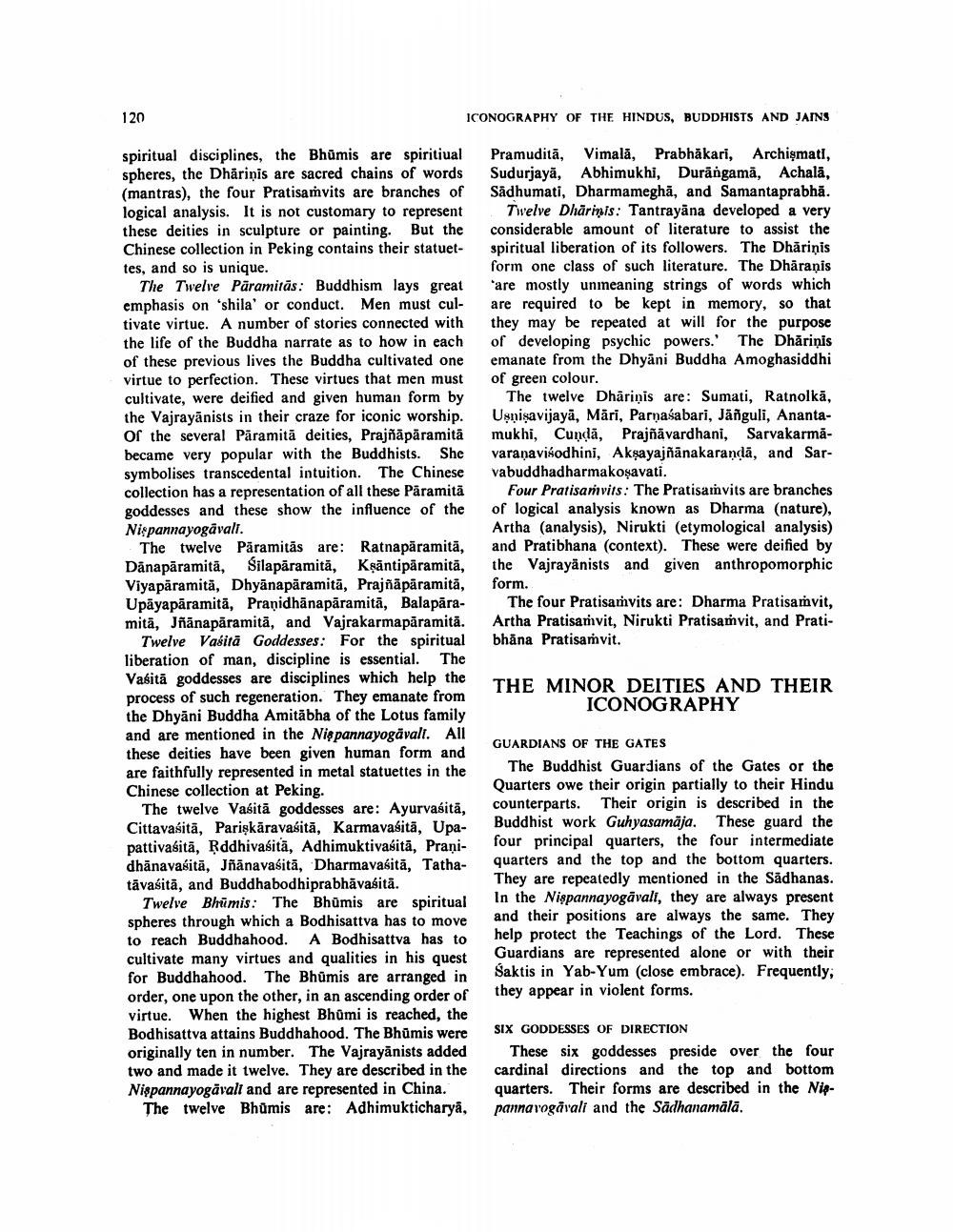________________
120
ICONOGRAPHY OF THE HINDUS, BUDDHISTS AND JAINS
spiritual disciplines, the Bhümis are spiritiual spheres, the Dhāriņis are sacred chains of words (mantras), the four Pratisamvits are branches of logical analysis. It is not customary to represent these deities in sculpture or painting. But the Chinese collection in Peking contains their statuettes, and so is unique.
The Twelve Pāramitās: Buddhism lays great emphasis on 'shila' or conduct. Men must cultivate virtue. A number of stories connected with the life of the Buddha narrate as to how in each of these previous lives the Buddha cultivated one virtue to perfection. These virtues that men must cultivate, were deified and given human form by the Vajrayānists in their craze for iconic worship. Of the several Pāramitā deities, Prajñāpāramitā became very popular with the Buddhists. She symbolises transcedental intuition. The Chinese collection has a representation of all these Pāramitā goddesses and these show the influence of the Nispannayogavalt.
The twelve Pāramitās are: Ratnapāramitā, Dänapäramită, Silapäramita, Kentipäramita, Vlyapāramith, Dhylnapiramita, Prajñāpāramith, Upayaparamita, Pranidhänapäramità, Balapäramitä, Jñänapäramitā, and Vajrakarmapāramitā.
Twelve Vasita Goddesses: For the spiritual liberation of man, discipline is essential. The Vašitā goddesses are disciplines which help the process of such regeneration. They emanate from the Dhyani Buddha Amitabha of the Lotus family and are mentioned in the Nispannayogavali. All these deities have been given human form and are faithfully represented in metal statuettes in the Chinese collection at Peking.
The twelve Vašitā goddesses are: Ayurvaśitā, Cittavasita, Pariṣkāravaśitā, Karmavaśitā, Upapattivaśitā, Ṛddhivaśitä, Adhimuktivaśitā, Pranidhānavaśitā, Jñānavaśitā, Dharmavaśitā, Tathatāvaśitā, and Buddhabodhiprabhavaśitā.
Twelve Bhumis: The Bhūmis are spiritual spheres through which a Bodhisattva has to move to reach Buddhahood. A Bodhisattva has to cultivate many virtues and qualities in his quest for Buddhahood. The Bhumis are arranged in order, one upon the other, in an ascending order of virtue. When the highest Bhumi is reached, the Bodhisattva attains Buddhahood. The Bhumis were originally ten in number. The Vajrayānists added two and made it twelve. They are described in the Nişpannayogavall and are represented in China.
The twelve Bhumis are: Adhimukticharya,
Pramuditā, Vimalā, Prabhakari, Archiṣmati, Sudurjaya, Abhimukhi, Durängamā, Achalā, Sadhumati, Dharmamegha, and Samantaprabhā. Twelve Dharinis: Tantrayana developed a very considerable amount of literature to assist the spiritual liberation of its followers. The Dhāriņis form one class of such literature. The Dharanis are mostly unmeaning strings of words which are required to be kept in memory, so that they may be repeated at will for the purpose of developing psychic powers.' The Dhariņis emanate from the Dhyani Buddha Amoghasiddhi of green colour.
The twelve Dharinis are: Sumati, Ratnolkā, Usniṣavijaya, Māri, Parṇaśabari, Jäñguli, Anantamukhi, Cunda, Prajñāvardhani, Sarvakarmavaraṇaviśodhini, Akṣayajñānakaraṇḍā, and Sarvabuddhadharmakoṣavati.
Four Pratisamvits: The Pratisamvits are branches of logical analysis known as Dharma (nature), Artha (analysis), Nirukti (etymological analysis) and Pratibhana (context). These were deified by the Vajrayānists and given anthropomorphic form.
The four Pratisamvits are: Dharma Pratisamvit, Artha Pratisamvit, Nirukti Pratisamvit, and Pratibhāna Pratisamvit.
THE MINOR DEITIES AND THEIR ICONOGRAPHY
GUARDIANS OF THE GATES
The Buddhist Guardians of the Gates or the Quarters owe their origin partially to their Hindu counterparts. Their origin is described in the Buddhist work Guhyasamāja. These guard the four principal quarters, the four intermediate quarters and the top and the bottom quarters. They are repeatedly mentioned in the Sadhanas. In the Nispannayogāvali, they are always present and their positions are always the same. They help protect the Teachings of the Lord. These Guardians are represented alone or with their Saktis in Yab-Yum (close embrace). Frequently, they appear in violent forms.
SIX GODDESSES OF DIRECTION
These six goddesses preside over the four cardinal directions and the top and bottom quarters. Their forms are described in the Nişpannavogavali and the Sadhanamālā.




